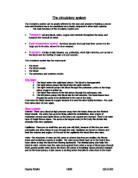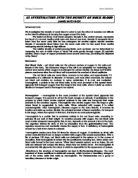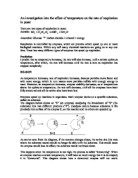The Assassin
The Assassin His motionless body lay there, covered in mud with rain pounding down through the thick layers of hedge covering him. his hair dark blonde and greasy, his face had a scar on his right cheek, his jacket was thick with a tear in the sleeve, the silver zip was broken and pulled right to the top, his trousers grey with black leather patches on the knees also torn where he had moved into position in the hedge, his socks odd and his shoes black leather. No expressions on his face as cars of all kinds pass, as he just stares down the hillside. His body blue with cold but yet he looks warm as though he cannot feel anything. His arms jerk as he once again sights his rifle towards the cottage at the bottom of the wooded hillside. He stares through the scope looking around the cottage. The house had thin blue line running across the front of the house the walls pale and worn out with bricks missing with ivy running up and around them. The roof had four chimney pots on it one with a bids nest on top and two with holes near the bottom the roofing was covered in moss and the tiles were cracked wear they were so old. The gutter was broke at the corner of the house it was leaking causing a puddle in the mud below, the windows were cracked and one of the top windows was boarded up with cardboard. As he stares at the door he notices that it has no number on it but the clean wood
The cardiac cycle
The cardiac cycle The cardiac cycle is the sequence of events that occur when the heart beats. There are two phases of this cycle: * Diastole - Ventricles are relaxed. * Systole - Ventricles contract. During the diastole phase the atria and ventricles are relaxed and the atrioventricular valves are open. De-oxygenated blood from the superior and inferior vena cava flows into the right atrium. The open atrioventricular valves allow blood to pass through to the ventricles. The SA node contracts triggering the atria to contract. The right atrium empties its contents into the right ventricle. The tricuspid valve prevents the blood from flowing back into the right atrium. During the systole phase the right ventricle receives impulses from the Purkinje fibers and contracts. The atrioventricular valves close and the semilunar valves open. The de-oxygenated blood is pumped into the pulmonary artery. The pulmonary valve prevents the blood from flowing back into the right ventricle. The pulmonary artery carries the blood to the lungs. There the blood picks up oxygen and is returned to the left atrium of the heart by the pulmonary veins. In the next diastole period, the semilunar valves close and the atrioventricular valves open. Blood from the pulmonary veins fills the left atrium. (Blood from the vena cava is also filling the right atrium.) The SA node contracts again
The circulatory system.
The circulatory system The circulatory system can be greatly affected by the type and amount of training a person does and therefore has to be considered very closely compared to other body systems. The main functions of the circulatory system are: * Transport- carrying blood, water, oxygen and nutrients throughout the body, and transport the removal of waste. * Body temperature control- the blood absorbs the body heat then carries it to the lungs and to the skin, where it is then released. * Protection- it helps to fight disease, e.g. antibodies, which fight infection, are carried in the blood and the clotting of seals cuts and wounds. The circulatory system has four main parts: * The heart * The blood vessels * The blood * The pulmonary and systemic circuits. The heart . The blood enters the right-hand atrium. The blood is deoxygenated. 2. The right atrium pumps this blood into the right ventricle. 3. The right ventricle pumps the blood through the pulmonary artery to the lungs where oxygen is picked up. 4. The blood then returns to the left atrium through the pulmonary vein. 5. The left atrium pumps the blood into the left ventricle. The blood leaves here through the aorta to be distributed to the rest of the body. From here the blood looses its oxygen because it is used for other bodily functions. The cycle then takes place all over again. Blood vessels
Stem Cell Research
The research of stem cells, particularly embryonic stem cells is a controversial issue in our society today. Stem cell research has an incredibly large potential in medicine and could dramatically affect the treatment of many human illnesses that would have previously been incurable. However there are many groups of people within our society that protest against the use of embryonic stem cells because they believe that it is not right to destroy living cells that have the potential to develop into living human beings. Numerous debates have occurred because of peoples' differing views on this topic. What Are Stem Cells? Stem cells are undifferentiated cells1; meaning they are cells in the body that have not yet become specialised. They have the potential to develop into any of the 220 specialised cells in the human body.2 For example stem cells can develop into cardiac muscle cells in the heart in the circulatory system, or into nerve cells in the nervous system. Each type of specialised cell has a unique structure that is specifically suited for its particular function. For example, nerve cells have thin, long extensions, which help them to transport electrical messages around the body more efficiently. 3 Once cells specialise, they cannot revert back to their previous stem cell state. This means that they can no longer specialise to form any other cell. Therefore it is
Tell Tale Heart.
Tell Tale Heart The narrator of this chilling tale is a strange character indeed, with no name and seemingly no existence, - it seems he has no family and no one really pays any attention to him, apart from one person... An innocent old man. As I go deeper into the story the narrator turns from strange to frightening, and unreliable. I feel that this narrator is like a vampire, sucking the blood from his victim - sucking out all the goodness out of life. When doing his dreadful deed he thinks nothing of it, he has succumbed to the taste and hunger of the killing, nothing else matters. However, after, the guilt inside begins to grow, the soul darkens at what has happened. His conscience takes over and he cannot hide the guilt and torment inside. The fact that the story ends with him telling all, it shows he has a conscience. A murdering man would never tell of his crimes if he didn't have a conscience. But what is a real conscience? People have a 'conscience' if they feel bad about something they've done, not necessarily telling anyone about what they did. So, if this harrowing tale ended without Mr 'Murder' telling all then we would think he didn't have a conscience at all, when, however, he might have been feeling bad throughout the evil doing, without letting on. Either way it's justified - he has a conscience. Throughout the telling of his story, the recall
Is cloning the way of the future ?
Topic Page number Is cloning the way of the future? 3 What is a clone? 5 The process of cloning 7 Cloning for medical purposes 3 How could cloning help in every day life? 6 Saving endangered animals 9 My conclusion 23 Bibliography 26 Cloning is an extremely controversial issue; in my case study I am going to be looking at both the positive and negative aspects of cloning and the scientific evidence behind it. I will also be looking at other aspects and writing a conclusion to all of the points which I have made. I have acknowledged that some sources of evidence like a newspaper article are not as reliable as scientific studies and text books however I have tried to include both. In this case study you will see how I have carefully compared both arguments for cloning in the future and recognise and evaluate all scientific evidence. All diagrams and references are clearly explained and all of their sources can be found in the bibliography located at the back page of my case study. The definition of a clone according to [www.word.net] is - a group of genetically identical cells or organisms derived from a single cell or individual by some kind of asexual reproduction. Meaning it is a genetic double. Identical twins are however another example of a clone even though they are formed through sexual reproduction. This is because they have exactly the same genetic
Short Story
Short Story. It was a dark, rainy, horrible night, it was 10 o'clock I had finished work for the day and left the stadium as usual where I worked as a cleaner. I noticed mist lurking over the muddy brown waters of the river. Then it hit me that need, want, death was in the air, I could almost taste it, the exact same way you could smell rotting bodies in a morgue; tonight was the night. I was hungry, I needed to kill. People were scared of me; maybe it was my long black greasy hair, my piercing blue eyes, my tall muscular physique or that scar. Whatever it was they always ignored me, like the poor broken bench that people only ever use if they have to. I followed the river round to the park and unlocked the door of the not quite so public toilet, where it all happens, I had the key because I was the one who locked it and made them out of order, and as I had done many times before hid in the bushes and waited, with my black knee length jacket making me hard to see in the shadows. It was unbearable waiting for the right woman to come along, waiting, waiting, waiting, it seemed an eternity. Then as if from nowhere, she was there passing from dark to light, light to dark in her high heeled shoes, pink jacket and cream coloured blouse with her skinny legs in the pouring rain, number 23. Each one exactly the same, young, shiny and ginger. She had a red leather bag with her,
Investigation into the density of mock blood.
A2 Investigation into the density of mock blood JAMES BATCHELOR INTRODUCTION We investigated the density of mock blood in order to see the effect of exercise and altitude on the blood's efficiency at carrying the oxygen around the body. We tested out three mock blood samples. Sample A, the control sample, represents the blood of a normal, healthy adult male who lives at sea level. Sample B represents blood taken from the same male after he has undergone six months regular aerobic exercise. Sample C represents blood taken from the same male after he has spent three months undergoing aerobic training at high altitude. The relative density of protein-carrying fluids, such as blood, can be determined by measuring the rate at which drops of 'blood' fall under gravity through copper (II) sulphate solution, since a layer of copper proteinate forms around each drop, preventing the dispersal of the 'blood.' RESEARCH Red Blood Cells - red blood cells are the primary carriers of oxygen to the cells and tissues of the body. The biconcave shape of the cell is an adaptation for maximizing the surface area across which oxygen is exchanged for carbon dioxide. Its shape and flexible plasma membrane allow the red blood cell to penetrate the smallest of blood capillaries. The red blood cells are round discs, concave on two sides, and approximately 7.5 thousandths of a millimeter in
Investigation into the effect of exercise on Heart Rate.
Investigation into the effect of exercise on Heart Rate. What do we mean by Heart Rate Heart Rate is the amount times your heart beats per minute. You can find heart Rate by taking your Pulse. Aim By doing this experiment I am trying to find out how your heart rate is effected by the amount of exercise you do. What Variable am I going to Use? I will use step-ups for a certain amount of time, timing for 1minute then taking my pulse 2minutes then taking my pulse and so on. This will show how the amount of exercise effects your heart rate. Hypothesis I predict that the more exercise that I do the faster my heart pump giving me a faster heart Rate. As I do more exercise my heart rate will increase this is because as more movement is present more energy will be needed and respiration is generated faster so takes place at a faster rate. Take a look at this scientific equation. Glucose Carbon Dioxide + Water + Energy If there is not enough oxygen being taken in by the body then Anaerobic Respiration must take place, but if more oxygen is taken in a waste product called Carbon Dioxide (CO2) is produced. This waste product must be removed, as it is a toxin. As more and more Carbon Dioxide is produced your blood pumps around your body faster in order to transport it and remove it from your body. This process will increase your heart rate and is
This experiment aims to discover how the intensity of an exercise can affect the heart rate of any given individual by testing their pulse rate after different amounts of exercise.
INTRODUCTION: This experiment aims to discover how the intensity of an exercise can affect the heart rate of any given individual by testing their pulse rate after different amounts of exercise. THEORY: Although we have chosen to investigate the amount of exercise and to measure the heart rate by using the pulse (two fingers on the main vein in the neck and count the beats over a period of 1 minute), there are other ways in which we could go about it. We felt that these ways were best to suit our experiment. How will the main input variable, i.e. the intensity of exercise, affect the output variable, i.e. the heart rate? First we need to know a bit about the heart and blood system. The heart is, besides the brain, one of the most important organs. It is a pump no bigger than your fist that pumps blood around the body. This means it must be incredibly strong and powerful. The heart acts as a double pump, pumping two circuits. One to the body (and head) and the other to the lungs. One side of the heart pumps de-oxygenated blood (the right side), and the left side pumps the oxygenated blood. But the heart's duties are much broader than simply pumping blood continuously throughout life. The heart must also be able to respond to changes in the body's demand for oxygen. The heart works very differently during sleep, for example, than in the middle of a 5-kilometre run. This is



























